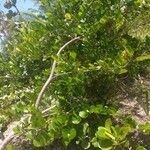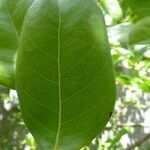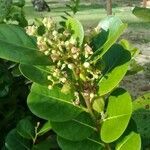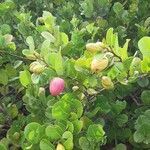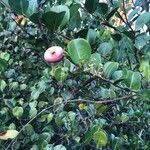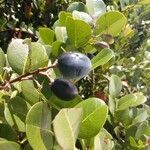Shrub or small tree to 5 m tall, the branches glabrous and lenticellate. Stipules 1-3 mm long, caducous. Leaves orbicular to ovate-elliptic, 2-8 by 2-6 cm, retuse, rounded or with short blunt acumen at apex, subcuneate at base, glabrous on both surfaces; petioles 2-4 mm. Inflorescences small terminal and axillary cymules or panicles of cymules, the rachis and branches grey-puberulous. Flowers 4-6 mm long. Receptacle campanulate-cupuliform, symmetrical, tomentose on exterior and interior. Calyx lobes rounded to acute, tomentellous on both surfaces. Petals white, glabrous, exserted. Stamens 15-26, the filaments joined for up to half of length in small groups, densely hairy, exserted. Ovary at base of receptacle, pilose. Fruit ovate to obovate, 2-5 cm long; epicarp smooth with longitudinal ridges; mesocarp thin and fleshy; endocarp thin, hard, ridged on exterior.
A shrub or small evergreen tree. It grows 1-6 m tall. The branches are long, flexible and whip-like. The leaves are evenly spaced and leathery. They are rounded and stiffly erect. They are simple and rich green. The flowers are small and greenish-white. They are in erect clusters in the axils of the leaves. The fruit is smooth and white, yellow, red, black or purple. It has a cotton like pulp. The fruit contains a large nut-like edible seed with 5 ridges.
Leaf-lamina suborbicular to lanceolate-elliptic, apex emarginate to acuminate, glabrous except for a few appressed hairs on both surfaces; petiole 0·2–0·4 cm. long; stipules intrapetiolar, 0·3 cm. long, boat-shaped, 2-fid, caducous.
Inflorescence axillary, up to 3 cm. long, but usually much less, a raceme of cymules, or a congested complex cyme, or flowers in subsessile fascicles.
Drupe variable in shape and size, ovoid, ellipsoid or obovoid, up to 5 cm. long, usually smaller.
Evergreen shrub or tree up to 30 m. tall.
Receptacle-tube c. 0·15 cm. long.
Stamens c. 0·3 cm. long.
Petals c. 0·25 cm. long.
Sepals c. 0·15 cm. long.
